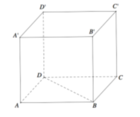Hãy nhập câu hỏi của bạn vào đây, nếu là tài khoản VIP, bạn sẽ được ưu tiên trả lời.

Đặt : \(\overrightarrow{BA}=\overrightarrow{a},\overrightarrow{BB'}=\overrightarrow{b,}\overrightarrow{BC}=\overrightarrow{c}\)
Ta có : \(\overrightarrow{BD'}=\overrightarrow{a}+\overrightarrow{b}+\overrightarrow{c}\)
Do MM//BD' nên tồn tại số thực k sao cho \(\overrightarrow{MN}=k\overrightarrow{BD'}\)
hay :
\(\overrightarrow{MN}=k\overrightarrow{a}+k\overrightarrow{b}+k\overrightarrow{c}\) (1)
Đặt
\(\frac{MC}{AC}=x,\frac{C'N}{C'D}=y;x,y\in\left(0;1\right)\)
Ta có :
\(\overrightarrow{AC}=\overrightarrow{c}-\overrightarrow{a,}\overrightarrow{C'D}=\overrightarrow{a}-\overrightarrow{b,}\)
Suy ra : \(\overrightarrow{MN}=\overrightarrow{MC}+\overrightarrow{CC'}+\overrightarrow{C'N}\)
\(=\overrightarrow{xAC}+\overrightarrow{CC'}+\overrightarrow{yC'N}\)
\(=x\left(\overrightarrow{c}-\overrightarrow{a}\right)+\overrightarrow{b}+y\left(\overrightarrow{a}-\overrightarrow{b}\right)\)
\(=\left(y-x\right)\overrightarrow{a}+\left(1-y\right)\overrightarrow{b}+x\overrightarrow{c}\) (2)
Từ (1) và (2) suy ra :
\(k\overrightarrow{a}+k\overrightarrow{b}+k\overrightarrow{c}=\left(y-x\right)\overrightarrow{a}+\left(1-y\right)\overrightarrow{b}+x\overrightarrow{c}\)
\(\Leftrightarrow\left(k+x-y\right)\overrightarrow{a}+\left(k+y-1\right)\overrightarrow{b}+\left(k-x\right)\overrightarrow{c}=\overrightarrow{0}\) (3)
Do \(\overrightarrow{a},\overrightarrow{b},\overrightarrow{c}\) không đồng phửng nên (3) tương đương với
\(\begin{cases}k+x-y=0\\k+y-1=0\\k-x=0\end{cases}\) \(\Leftrightarrow\begin{cases}x=\frac{1}{3}=k\\y=\frac{2}{3}\end{cases}\)
Vậy với \(3\overrightarrow{MC}=\overrightarrow{AC,}3\overrightarrow{C'N}=2\overrightarrow{C'D}\)
thì MN//BD' và khi đó \(\frac{MN}{BD'}=\frac{1}{3}\)

Đáp án D
Có hình chiếu của AC' xuống đáy là AC mà AC ⊥ BC nên AC'BD.




a) Ta có:
Gọi I là tâm hình vuông BCC'B'
Trong mặt phẳng (BC'D') vẽ IK ⊥ BD' tại K
Ta có IK là đường vuông góc chung của BD' và B'C
b) Gọi O là trung điểm của BD'
Tam giác BC’D’ có OI là đường trung bình nên :
Vì ΔIOB vuông tại I có đường cao IK nên: